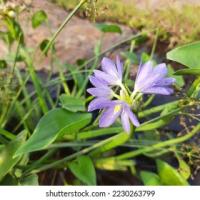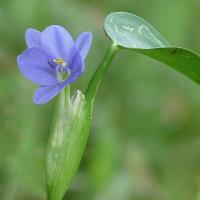Heartshape false pickerelweed
Monochoria vaginalis
Monochoria vaginalis, commonly known as heartleaf false pickerelweed, is an aquatic plant species belonging to the family Pontederiaceae. It is native to various regions, including parts of Asia, Africa, and Australia, and is often found in aquatic environments such as ponds, lakes, marshes, and slow-moving streams. Here is a description of Monochoria vaginalis:
Appearance:
- Heartleaf false pickerelweed is an aquatic perennial plant that typically grows in water or on the edges of aquatic habitats.
- The leaves are heart-shaped or somewhat triangular, hence the common name "heartleaf," and they are typically green with a glossy texture.
- The plant produces erect or floating stems that can vary in height but often reach lengths of 1 to 3 feet (30 to 90 cm).
- The flowers of Monochoria vaginalis are small and inconspicuous, typically pale blue to lavender in color, and they are borne on slender stalks.
- The root system of the plant is adapted for an aquatic environment, with rhizomes that allow it to spread in submerged or shallow water habitats.
Habitat:
- Heartleaf false pickerelweed is primarily an aquatic or semi-aquatic plant, and it is commonly found in freshwater bodies such as ponds, lakes, marshes, and slow-moving streams.
- It thrives in areas with standing or slow-moving water and can tolerate a range of water depths.
Lifecycle:
- Monochoria vaginalis is a perennial plant, meaning it can persist for multiple growing seasons.
- It reproduces both by seed and vegetatively through the growth of rhizomes, allowing it to form dense colonies in suitable aquatic habitats.
Ecological Impact:
- In some regions, heartleaf false pickerelweed can become invasive and disrupt native aquatic ecosystems by forming dense mats on the water's surface, which may shade out native aquatic plants.
- Its invasive potential has raised concerns in areas where it has been introduced and become a dominant species.
Control:
- Control measures for heartleaf false pickerelweed in aquatic environments may include manual removal, mechanical or physical control methods, and, in some cases, the use of approved herbicides or biological control agents.
- Managing the plant's spread and preventing its establishment in new areas is crucial to minimizing its ecological impact.
The presence of Monochoria vaginalis in aquatic ecosystems, particularly when it becomes invasive, can impact the balance of native aquatic vegetation and affect water quality. Therefore, appropriate management strategies are essential in areas where it poses a threat to native biodiversity and ecological stability.









Plant Protection Products
- N/A
- N/A
- N/A
- N/A
- N/A
- N/A
- N/A
- N/A
- N/A
- N/A
- N/A
- N/A
- N/A
- N/A
- N/A
- N/A
- N/A
- N/A
- N/A
- N/A
- N/A
- N/A
- N/A
- N/A
- N/A
- N/A
- N/A
- N/A
- N/A
- N/A
- N/A
- N/A
- N/A
- N/A
- N/A
- N/A
- N/A
- N/A
- N/A
- N/A
- N/A
- N/A
- N/A
- N/A
- N/A